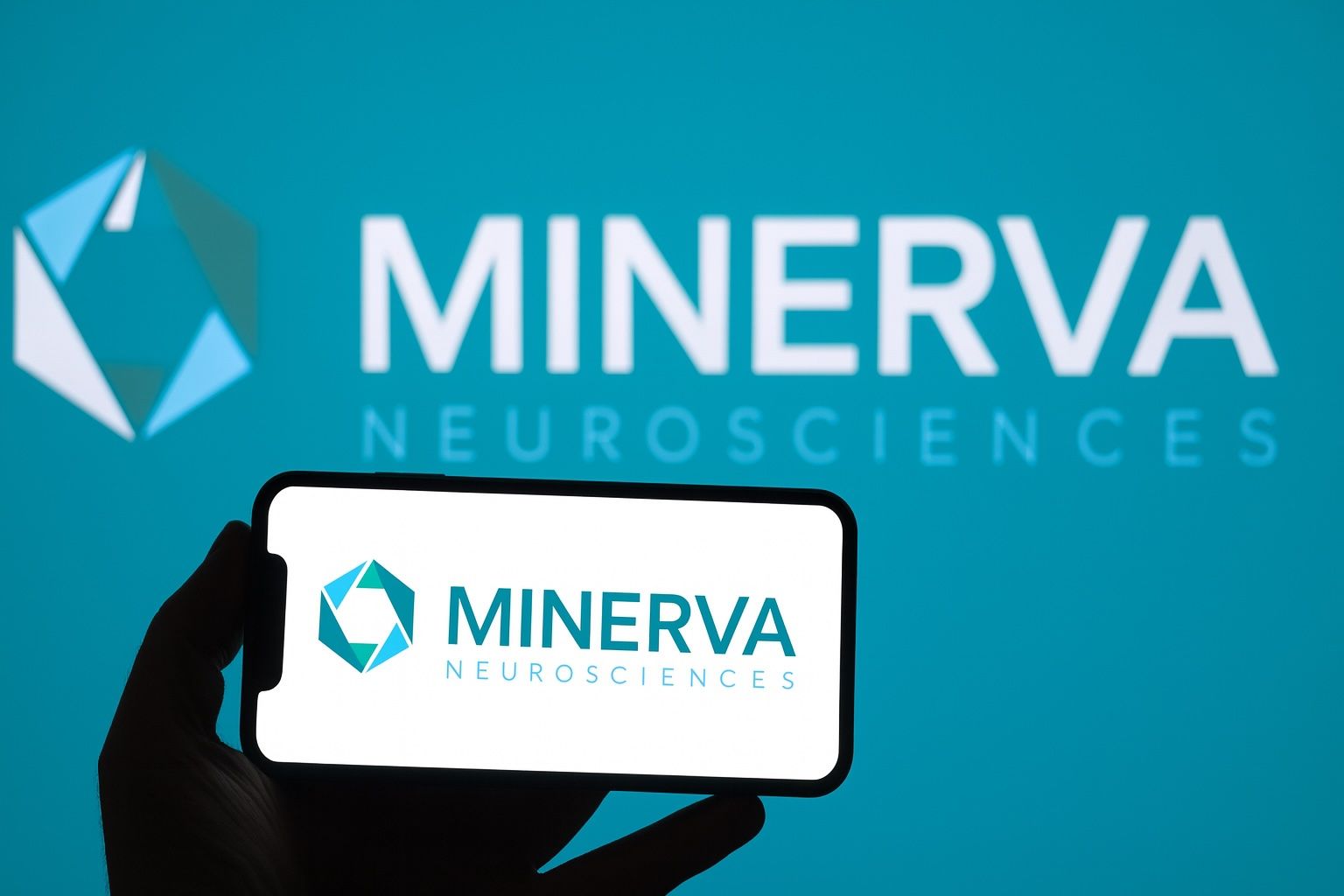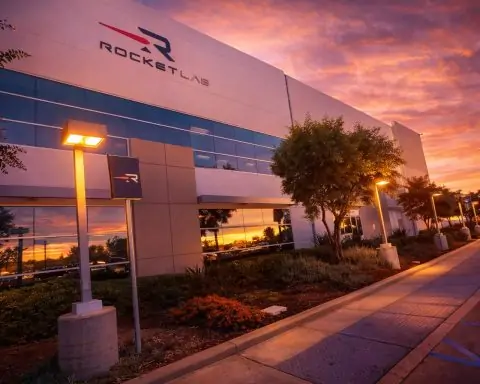- Shares Triple on Financing News: Minerva Neurosciences (NASDAQ: NERV) stock soared over 150% on October 21, 2025, hitting a new 52-week high (~$6.80 intraday) after closing at $2.66 the prior day [1]. The explosive rally came on unusually heavy volume (~39.5 million shares vs ~0.5 million average) [2] [3]. Year-to-date gains ballooned from ~20% to well over 100% following this surge [4].
- $200 Million Funding Deal: The company announced a private placement agreement with institutional investors to raise up to $200 million in gross proceeds [5] [6]. An initial $80 million is provided upfront via a new Series A preferred stock issuance, with another $120 million contingent on warrant exercises tied to future milestones [7]. The financing is led by Vivo Capital and includes major healthcare-focused funds like Janus Henderson, Farallon, and others [8].
- Cash Infusion Targets Schizophrenia Drug: Proceeds will fund a confirmatory Phase 3 trial of Minerva’s lead drug roluperidone and the resubmission of its New Drug Application (NDA) to the FDA [9] [10]. Roluperidone is being developed for the negative symptoms of schizophrenia, a serious unmet medical need. Minerva and the FDA have aligned on the trial design as of August, clearing a regulatory path forward [11]. The new capital is expected to carry Minerva through the Phase 3 trial and NDA filing [12], positioning the company for a potential U.S. launch if approved.
- CEO & Experts Weigh In: Minerva CEO Dr. Remy Luthringer said the team will “refocus all of our efforts on the successful execution of the confirmatory trial” to demonstrate roluperidone’s efficacy for patients with debilitating negative symptoms [13]. Psychiatric Times editor-in-chief Dr. John J. Miller noted that treatments for negative symptoms “have remained elusive,” contributing greatly to schizophrenia patients’ impairments [14] – underscoring the high stakes for roluperidone. Industry analysts view the financing as a crucial lifeline that reduces near-term execution risk for Minerva [15], though they caution it comes at the cost of potential dilution and hinges on clinical success [16].
- Stock Outlook and Analyst Sentiment: Prior to this week’s developments, Wall Street’s outlook on NERV was muted – the stock carried a “Reduce” consensus rating (no Buy ratings, one Hold, one Sell) and a modest $5 average price target [17] [18]. Those targets have now been eclipsed by the stock’s post-rally price. Coverage is sparse given Minerva’s micro-cap status (market cap was under $20M before the spike, now ~$48M [19]). While the cash boost and FDA guidance have markedly improved Minerva’s prospects, skeptics note the company remains pre-revenue with ongoing losses and even previously had negative shareholders’ equity [20]. Automated analysis from TipRanks’ AI recently rated NERV an Underperform, citing “significant financial instability, marked by negative equity and a lack of revenue” [21]. Going forward, investors and analysts expect high volatility as Minerva enters the pivotal trial phase – success could unlock further funds (via warrants) and revive hopes of approval, whereas any setbacks would reignite concerns about its viability.
Stock Soars on Major Funding News
Minerva Neurosciences’ stock chart went vertical on Tuesday after the biotech announced an expansive financing deal that effectively triples the company’s market capitalization overnight [22]. In pre-market trading on Oct. 21, NERV stock jumped as much as 160% on the news [23]. The shares opened around $6–7 (up from ~$2.66 prior close) and oscillated near those levels through the day, ultimately marking a 52-week high of $6.97 [24]. By comparison, NERV had traded as low as $1.15 within the past year [25], reflecting both the dramatic rebound and the extreme volatility inherent in this micro-cap biotech.
Such a parabolic one-day gain is rare and signals intense investor interest. Indeed, volume on Oct. 21 exceeded 39 million shares, hundreds of times the normal daily volume around a few hundred thousand [26] [27]. The frenzy suggests that news of the funding deal – which shores up Minerva’s cash position and chances of advancing its drug – triggered a rush of speculative buying, short covering, or both. Just a day earlier, the stock had quietly risen about 5–7% in anticipation (closing at $2.66 on Oct. 20) [28]. But once the full details hit the wire Tuesday morning, NERV skyrocketed, ultimately closing the session up roughly 150% from the prior day (exact closing price to be confirmed by end-of-day trading data).
This breakout rally puts Minerva’s stock well above levels it traded at for most of the past year. As noted, the new ~$6+ price blew past analysts’ prior $5 target [29], indicating Wall Street underestimated the potential impact of a major capital infusion. Even with the surge, Minerva’s absolute valuation remains modest (around $50 million market cap) – highlighting that the company was priced for distress before this deal. The question now is whether the rally can hold in coming weeks as the initial euphoria fades and investors refocus on execution risks ahead.
$200M Lifeline to Fund Roluperidone Phase 3 and NDA
The catalyst for the stock’s explosion was Minerva’s announcement of a significant financing agreement aimed at rescuing and accelerating its lead program. The company entered into a securities purchase agreement with a consortium of healthcare-focused institutional investors to raise up to $200 million in new capital [30] [31].
Deal structure: The financing is a private placement that will issue Series A convertible preferred stock and warrants rather than common equity upfront. Minerva will immediately receive $80 million in cash from the sale of the preferred shares [32]. The investors also get Tranche A warrants that, if fully exercised for cash, would bring in another $80 million [33]. These Tranche A warrants become exercisable once Minerva achieves a key milestone – specifically, successful completion of the upcoming Phase 3 trial’s primary endpoint in schizophrenia [34] [35]. In other words, an additional $80M is essentially contingent on positive Phase 3 results. A further $40 million (Tranche B warrants) could be raised down the road upon either the same trial success or after three years, though those can be exercised without cash (indicating less certainty of that portion) [36] [37]. If all warrants eventually convert, the total financing would reach the full $200M. The deal is expected to officially close on or about October 23, 2025 [38], subject to standard conditions.
Investors and credibility: The funding round is led by Vivo Capital LLC, a healthcare venture firm, and includes participation from several well-known biotech investors [39]. Named participants span both new and existing Minerva stakeholders, such as Janus Henderson, Federated Hermes Kaufmann Funds, Farallon Capital, Balyasny Asset Management, Foresite Capital, and others [40]. The breadth of investors – many of whom specialize in life sciences – and the sheer size of the raise (massive relative to Minerva’s prior market cap) provide a strong vote of confidence in the potential of roluperidone. Jefferies LLC acted as the sole placement agent, indicating involvement of a major investment bank in arranging the deal [41].
Use of proceeds: Minerva is earmarking the funds almost entirely for roluperidone’s development and commercialization efforts. According to the announcement, the cash will be used to “finance the confirmatory Phase 3 trial of roluperidone (including upsizing the trial), [for] preparation and resubmission of its NDA, [and] readiness of the commercial launch… if approved,” as well as general corporate purposes [42]. In effect, this one deal should fund Minerva through the critical milestones needed to (hopefully) bring roluperidone to market – i.e. completing the new Phase 3 study, getting FDA approval, and preparing to launch in the U.S. [43]. Company officials noted that with this financing and recent FDA alignment, Minerva is now sufficiently funded through the trial and NDA phase [44], a luxury it did not have just a week ago.
Notably, the agreement also stipulates changes in corporate governance: Minerva will expand its Board of Directors by up to three seats, to be filled by directors designated by the new investors who have significant schizophrenia clinical trial experience [45] [46]. This is intended to “strengthen and support clinical operations management” for the Phase 3 trial [47] [48]. Bringing seasoned experts onto the board could help Minerva navigate the complex trial and regulatory process ahead (and perhaps satisfy investors that their money will be overseen by industry veterans). It’s fairly common for investors in suchPIPE deals to seek board representation, especially when a small company is essentially being rebuilt through a major capital infusion.
Roluperidone’s Promise and Previous Setbacks
Minerva’s entire future hinges on roluperidone, its experimental treatment for the negative symptoms of schizophrenia. These symptoms – such as social withdrawal, apathy, and blunted emotional expression – represent a huge unmet need. Roughly 50–60% of people living with schizophrenia experience at least one persistent primary negative symptom [49], and currently no approved medications specifically target this aspect of the illness. Standard antipsychotic drugs primarily address positive symptoms like hallucinations and delusions, often with little effect on (or even worsening of) negative and cognitive symptoms. This leaves a major gap in care. As CEO Remy Luthringer emphasized, “Minerva is developing roluperidone for the treatment of patients suffering from the negative symptoms of schizophrenia”, with the goal of finally providing a therapy for these impairments [50].
Roluperidone (also known by the code MIN-101) is a novel compound that modulates sigma2 and serotonin receptors, among others, without directly hitting dopamine receptors (unlike typical antipsychotics). The idea is to improve negative symptoms without the side effects of dopaminergic drugs. In an earlier Phase 2b study, roluperidone did show a statistically significant improvement in negative symptoms vs. placebo [51]. However, Minerva’s road to approval has been anything but smooth:
- In October 2022, the FDA refused to file Minerva’s first NDA submission for roluperidone, essentially rejecting it at the door due to insufficient evidence [52]. Regulators weren’t convinced that the single positive Phase 2b/3 study was enough to prove effectiveness, and they noted a lack of long-term safety data at the highest dose, among other issues [53] [54]. This was a major setback that cratered the stock at the time (it lost more than 60% in one day back in 2020 when initial Phase 3 results disappointed [55], and again in 2022 on the FDA refusal).
- Minerva pursued a formal dispute resolution and appealed the refusal. The FDA eventually allowed the company to resubmit the NDA in 2023, which led to a full review – but in February 2024, the FDA issued a Complete Response Letter (CRL), declining to approve roluperidone [56]. The CRL reiterated that Minerva must provide at least one more positive, well-controlled study to establish substantial evidence of efficacy, among other requirements [57]. In short, the FDA wants a confirmatory Phase 3 trial to back up the drug’s benefit, as well as additional safety data (especially in combination with existing antipsychotics, since many patients will continue those medications) [58] [59].
Facing these hurdles, Minerva’s strategy through 2024 was to work with the FDA on designing an acceptable new trial and to find the money to actually run it. By mid-2025, the company had aligned with FDA on a Phase 3 trial design (achieved in August) [60] and even mentioned exploring “strategic alternatives” to maximize shareholder value (often code for seeking partnerships or sale) [61]. The stock saw a modest lift in August on news that Minerva was considering all options and had the FDA’s guidance – it jumped ~25% to around $2.25 after those updates [62]. Still, investors knew that without a substantial capital raise or deal, Minerva might not survive long enough to conduct the required trial.
That backdrop sets the stage for this week’s financing: it is essentially Minerva’s lifeline to give roluperidone one more shot at proving itself. With $80M now (and potentially more later), the company can finally launch the confirmatory Phase 3. According to Minerva, the trial will be larger (“upsized”) and incorporate FDA’s feedback – for example, ensuring a sufficient number of patients are tested at the target 64mg dose for a full year, and possibly tracking outcomes like relapse rates when roluperidone is used without other antipsychotics (to pursue a monotherapy indication) [63] [64]. Patients in the trial will likely be those with persistent negative symptoms despite stable positive symptom control (similar to prior studies). Results from this trial, if positive, would allow Minerva to resubmit the NDA perhaps in a couple of years. Given typical study durations, investors might expect top-line Phase 3 data by late 2026, though no official timeline has been announced yet.
Both company leadership and outside experts stress how high the stakes are. “We believe that roluperidone is a safe and effective therapy … and will continue to work closely with the FDA … with the goal of bringing this much-needed therapy to patients,” Dr. Luthringer said earlier this year after the CRL [65] [66]. Clinicians echo the need: “The combination of cognitive and negative symptoms contributes greatly to the functional impairment of many patients with schizophrenia,” noted Dr. John J. Miller of Psychiatric Times, underscoring that new treatments for negative symptoms could be transformative [67]. If roluperidone eventually succeeds, it would be one of the first approved therapies for negative symptoms, potentially addressing a patient population numbering in the millions globally [68]. This helps explain why specialist biotech investors were willing to pour $200M into Minerva – the upside, while still very uncertain, could be enormous from both a clinical and commercial perspective.
However, Minerva must now execute flawlessly on the trial. The financing has bought the company time and resources, but the hard work of enrollment and trial management lies ahead. To aid in this, the addition of board members with schizophrenia trial experience is a positive, as is the continued guidance from FDA to ensure the study meets regulatory expectations. Still, as with any trial, there is no guarantee of success – past results for roluperidone have been mixed, and the FDA will require not just statistical significance but evidence that the drug’s effect is clinically meaningful for patients’ lives [69]. Investors enamored by the vision of an approved drug in a few years must remember that key hurdles remain before roluperidone can reach the finish line.
Financial Condition and Business Updates
Beyond the headline-grabbing stock move, it’s worth examining Minerva’s financial and operational state as it enters this new chapter. As a clinical-stage biotech, Minerva has no product revenues (and will not unless and until roluperidone or another pipeline candidate is approved). The company has historically funded itself through equity raises and partnerships. Prior to the new financing, Minerva’s balance sheet was under strain – cash was depleting and annual net losses have been the norm (for example, a net loss of $3.8 million was reported in Q1 2025) [70]. In the second quarter 2025 business update, Minerva even disclosed it was reviewing strategic alternatives including possible mergers or asset sales [71], a signal that without new funding, it might not sustain operations through the lengthy trial process.
Despite these challenges, Minerva entered this week with some financial green lights that likely helped attract investors. The company had zero debt on its books and a strong current ratio (~6.1), indicating decent short-term liquidity [72] [73]. It has also kept a relatively lean operation – R&D spending was scaled back after the FDA setbacks to conserve cash, and G&A expense has been stable (around $2.5M per quarter) [74]. Having no debt is especially noteworthy; it means all new funds can go directly into development rather than servicing liabilities, and it avoids the risk of creditors in a pinch. GuruFocus analysts recently commented that Minerva “exhibits strong financial health with no debt and a high current ratio,” albeit typical for a pre-revenue biotech to burn cash [75]. Indeed, Minerva’s free cash flow was deeply negative (as expected for a company running trials) and it had a high accumulated deficit. The fresh $80M injection should significantly extend its cash runway – likely enough to start and conduct the Phase 3 trial through key interim readouts. If the trial meets its endpoints, the warrant exercises could bring in even more cash, further bolstering Minerva’s finances for NDA filing and pre-commercial activities.
On the corporate development front, aside from roluperidone, Minerva’s pipeline isn’t very active. The company had previously in-licensed or developed other CNS compounds (seltorexant for insomnia/depression, MIN-117 for depression, MIN-301 for Parkinson’s) [76], but most of these have been deprioritized or partnered out. Essentially, Minerva is a one-drug story right now, which magnifies both the risk and reward. The infusion of capital and added board expertise indicate the company and its backers are “all-in” on roluperidone.
It’s also notable that Minerva’s stock had been languishing at very low levels (sub-$3) for months, reflecting investor skepticism. Even so, there was a slight upward drift in the weeks before the financing announcement – possibly on rumors or hope of a deal. The stock was around $2.50 in mid-October, up from near $2 in the summer, and as mentioned, got a bump to $2.25+ in August when strategic review news hit [77]. In essence, some of the worst-case scenario (e.g. bankruptcy or a fire-sale) was coming out of the stock as Minerva signaled it had a plan. The confirmation of that plan this week – via a concrete $200M deal – dramatically revalued the company. Investors now see a funded path forward rather than a cash-starved biotech on the brink. The stock’s new ~$6 price also potentially makes future equity raises (if needed) less dilutive, though the current deal already involves significant potential dilution through preferred stock conversion (each preferred share will convert to common at $2.11/share upon shareholder approval) [78]. Minerva will be seeking shareholder approval to authorize more shares for those conversions, which, if the price stays elevated, should be achievable.
Analyst and Market Perspectives
Before this week’s news, external coverage of NERV was limited and generally cautious. According to MarketBeat, Minerva had just two analysts officially covering it recently, with a consensus rating of “Reduce” (on a scale where that is worse than Hold) [79]. The lone price target averaged about $5.00 per share [80], which the stock has now overshot. TipRanks data suggests that earlier in the year a number of analysts had actually rated Minerva a Sell – in fact 0 Buy, 1 Hold, and as many as 6 Sell ratings were on record, reflecting negativity after the FDA rejection in early 2024 [81]. Many of those analysts may have ceased active coverage as the company’s prospects looked dim. In any case, sentiment is likely to evolve now that Minerva’s survival is less in question.
Some financial commentators are already providing updated takes. GuruFocus noted the stock “skyrocketed” on the financing/NDA plan and highlighted that Minerva’s market cap was only ~$18.6M before the move [82] [83] – a hint at how much upside investors see if roluperidone succeeds. They also pointed out the high volatility (beta ~1.95) and the binary nature of the company’s risk profile [84] [85]: with essentially one key asset, Minerva is either on the cusp of a breakthrough or bust. The balance sheet strengths (no debt, high cash ratios) are a plus [86], but the lack of any revenue or approved product means valuation is tricky. In fact, some metrics made Minerva look “cheap” – for example, a peculiar P/E ratio around 1.8 was reported before the rally [87] [88], but this is not very meaningful given the company’s net income came from one-time accounting credits (and will turn back to losses as R&D ramps up). More relevant is the price-to-book ratio – Minerva was trading below book value (book was negative, effectively) [89], which often signals distress. The new cash will improve the book value and likely turn equity positive again, removing that red flag.
On the forecast front, prior quantitative models were bearish on NERV. For instance, before the deal a stock-forecasting site had predicted NERV would drop to ~$2.52 by mid-November 2025 [90], in the absence of catalysts. Clearly, that scenario is out the window now. The stock’s trajectory will instead depend on milestones like trial progress updates, interim data (if any), and eventual Phase 3 results. It’s possible analysts from firms involved in the deal (or those who follow small-cap biotech) will update their views in the coming days. Key questions they will examine include: Has Minerva secured enough money to reach approval, or will it need more? Will existing shareholders face substantial dilution? What is the probability of trial success, and what might an approved roluperidone be worth in the marketplace?
Early takes show a mix of optimism and caution:
- Optimism: “Minerva raises structured capital and gains FDA alignment to fund a confirmatory Phase 3 and NDA resubmission, reducing near‑term execution risk,” wrote a biotech financing analyst at StockTitan [91]. The sentiment is that the financing substantially de-risks the company’s near-term outlook – it no longer has a funding overhang or regulatory ambiguity on trial design. Bulls argue that with money in hand and a clear plan, Minerva can focus on science and execution, and if roluperidone works, today’s ~$6 stock could climb much higher. The involvement of reputable biotech funds is seen as validating the science to some degree (they likely did due diligence and see a path to ROI). Furthermore, if Phase 3 results are positive, Minerva could become an attractive takeover candidate for a larger pharma company looking to add a schizophrenia franchise – a not-uncommon outcome in biotech.
- Caution: On the other hand, skeptics emphasize that dilution from this deal is significant – the preferred stock will convert into common shares (pending a shareholder vote) at $2.11 each [92], meaning potentially tens of millions of new shares could hit the market (the exact number depends on how many preferred shares are issued and warrants exercised, but it could roughly triple the share count or more). Existing shareholders will own a much smaller slice of the company unless roluperidone’s success also dramatically increases the pie (i.e. the company’s valuation). “Potential shareholder dilution” was flagged as a key concern by analysts dissecting the deal [93]. Additionally, the final $40M of the financing is contingent on a “milestone event” and is not guaranteed [94], meaning if the trial fails, Minerva would not get that cash yet still have the expense burden of the attempt. Even with the money, executing a large Phase 3 in schizophrenia is challenging – such trials are lengthy, require enrolling hundreds of patients (possibly globally), and outcomes can be hard to predict. As one AI-driven analyst model bluntly stated, the company still has no revenues and negative equity and thus judged the stock an Underperform despite the rally [95]. That view encapsulates the risk that if roluperidone ultimately fails, this financing might only delay an unhappy ending for Minerva.
Market reaction going forward will likely be volatile as these opposing perspectives play out. In the near term, the stock’s huge gain could invite some profit-taking or short-selling by those who feel the jump was excessive. Conversely, momentum or biotech-focused traders might continue to bid up shares if they believe more good news is coming (e.g. perhaps partnership announcements or simply the removal of bankruptcy risk warrants a higher valuation). The stock’s journey from here will also depend on broader market sentiment toward biotech, which can swing with risk appetite.
Conclusion and Future Outlook
As of late October 2025, Minerva Neurosciences has dramatically altered its trajectory. The infusion of up to $200 million gives this small company a fighting chance to prove its worth by executing the critical Phase 3 trial for roluperidone. The stock’s eye-popping rally reflects a combination of short-term trading dynamics and genuine fundamental repricing – Minerva is no longer a near-cash-out penny stock but a funded development-stage biotech with a clear mission. For patients and clinicians in the schizophrenia community, the progress is encouraging: a potential therapy for negative symptoms is moving forward again after earlier regulatory setbacks.
Looking ahead, investors should brace for a long road: pivotal trial results are likely a year or two away, and only success will unlock the next stages of value (including that additional $80M from warrant exercises). Minerva’s management will need to hit clinical and regulatory milestones on schedule to maintain credibility. Any delays, trial hiccups, or safety issues could dampen the optimism quickly. Conversely, positive interim signals or partnership deals (for example, Minerva might seek a commercialization partner if data is good) could further boost the stock.
For now, Minerva has regained the market’s attention in dramatic fashion. The company’s narrative has shifted from one of desperation to one of “cautious hope”. As CEO Luthringer put it, millions of patients could someday benefit if roluperidone succeeds [96]. That prospect is what underlies the current rally – and it will be the yardstick by which Minerva’s ultimate success or failure is measured. In the words of Dr. Miller, an expert in the field, addressing negative symptoms would be a game-changer since current treatments leave many patients still struggling [97]. With money in the bank and experts on board, Minerva now has its shot to deliver on that promise.
Sources: Financial news and filings [98] [99] [100] [101] [102] [103] [104] [105], company press releases [106] [107], Psychiatric Times [108] [109], and MarketBeat/analyst data [110] [111]. (All information is up to date as of Oct. 21, 2025.)
References
1. stockanalysis.com, 2. www.tipranks.com, 3. www.marketbeat.com, 4. www.tipranks.com, 5. www.tipranks.com, 6. www.gurufocus.com, 7. www.gurufocus.com, 8. www.globenewswire.com, 9. www.tipranks.com, 10. www.stocktitan.net, 11. www.stocktitan.net, 12. www.stocktitan.net, 13. www.stocktitan.net, 14. www.psychiatrictimes.com, 15. www.stocktitan.net, 16. www.stocktitan.net, 17. www.marketbeat.com, 18. www.marketbeat.com, 19. www.marketbeat.com, 20. www.tipranks.com, 21. www.tipranks.com, 22. www.marketbeat.com, 23. www.gurufocus.com, 24. www.marketbeat.com, 25. www.marketbeat.com, 26. www.tipranks.com, 27. www.marketbeat.com, 28. www.tipranks.com, 29. www.marketbeat.com, 30. www.tipranks.com, 31. www.gurufocus.com, 32. www.gurufocus.com, 33. www.stocktitan.net, 34. www.stocktitan.net, 35. www.stocktitan.net, 36. www.stocktitan.net, 37. www.stocktitan.net, 38. www.stocktitan.net, 39. www.globenewswire.com, 40. www.globenewswire.com, 41. www.globenewswire.com, 42. www.stocktitan.net, 43. www.stocktitan.net, 44. www.stocktitan.net, 45. www.globenewswire.com, 46. www.globenewswire.com, 47. www.globenewswire.com, 48. www.stocktitan.net, 49. www.globenewswire.com, 50. www.stocktitan.net, 51. www.psychiatrictimes.com, 52. en.wikipedia.org, 53. www.psychiatrictimes.com, 54. www.psychiatrictimes.com, 55. www.marketbeat.com, 56. www.psychiatrictimes.com, 57. www.psychiatrictimes.com, 58. www.psychiatrictimes.com, 59. www.psychiatrictimes.com, 60. www.stocktitan.net, 61. ir.minervaneurosciences.com, 62. news.moomoo.com, 63. www.stocktitan.net, 64. www.psychiatrictimes.com, 65. www.psychiatrictimes.com, 66. www.psychiatrictimes.com, 67. www.psychiatrictimes.com, 68. www.globenewswire.com, 69. www.psychiatrictimes.com, 70. ir.minervaneurosciences.com, 71. ir.minervaneurosciences.com, 72. www.gurufocus.com, 73. www.gurufocus.com, 74. ir.minervaneurosciences.com, 75. www.gurufocus.com, 76. www.gurufocus.com, 77. news.moomoo.com, 78. www.globenewswire.com, 79. www.marketbeat.com, 80. www.marketbeat.com, 81. www.tipranks.com, 82. www.gurufocus.com, 83. www.gurufocus.com, 84. www.gurufocus.com, 85. www.gurufocus.com, 86. www.gurufocus.com, 87. www.gurufocus.com, 88. www.gurufocus.com, 89. www.tipranks.com, 90. coincodex.com, 91. www.stocktitan.net, 92. www.globenewswire.com, 93. www.stocktitan.net, 94. www.stocktitan.net, 95. www.tipranks.com, 96. www.globenewswire.com, 97. www.psychiatrictimes.com, 98. www.tipranks.com, 99. www.stocktitan.net, 100. www.globenewswire.com, 101. www.stocktitan.net, 102. www.psychiatrictimes.com, 103. www.stocktitan.net, 104. www.marketbeat.com, 105. www.marketbeat.com, 106. www.stocktitan.net, 107. www.stocktitan.net, 108. www.psychiatrictimes.com, 109. www.psychiatrictimes.com, 110. www.marketbeat.com, 111. www.gurufocus.com








